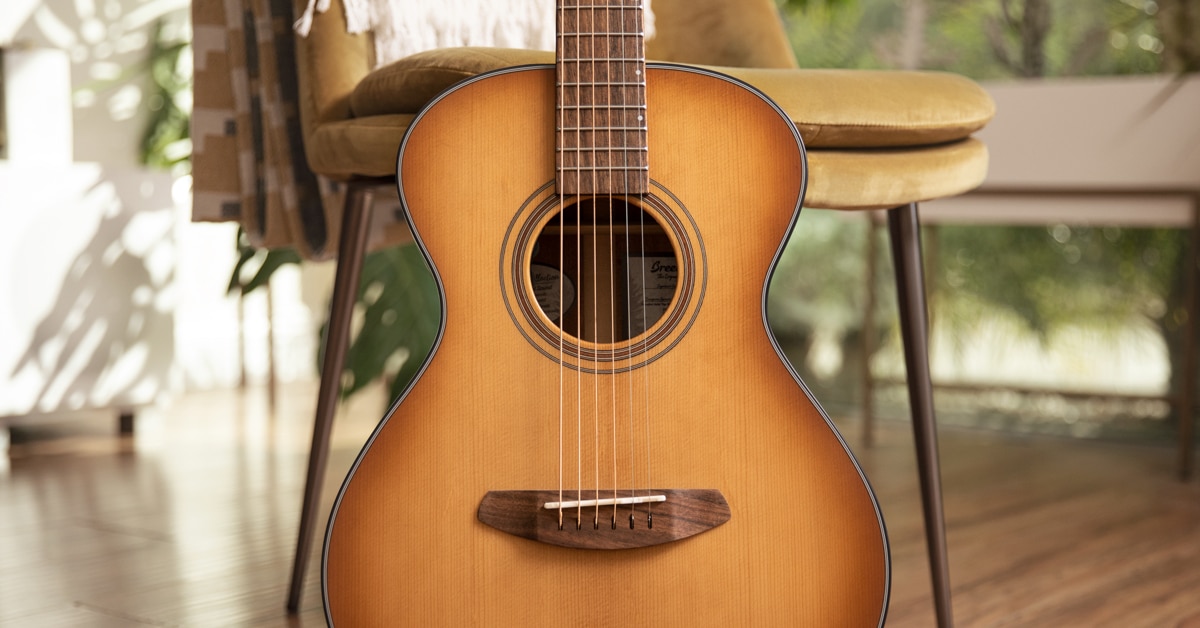We’ve written this guide with the details you need to find the best acoustic guitar strings. We'll help you understand the difference between various acoustic guitar strings, including material, gauge, winding style and coated acoustic strings versus uncoated acoustic strings. Read on for helpful advice about choosing the right acoustic strings for your playing style, sound and guitar.
Looking to find the best electric guitar strings? Check out our Electric Guitar String Buying Guide.
Table of Contents
Acoustic Guitar Strings
Acoustic Guitar Strings vs. Classical Guitar Strings
All About Acoustic Guitar String Gauges
Acoustic Guitar Steel Strings
Do Acoustic-Electric Guitars Need Different Strings?
Classical Guitar Nylon Strings
When Should I Change My Acoustic Guitar Strings?
How Often Should Acoustic Guitar Strings be Changed?
Acoustic Guitar String Maintenance Tips
Acoustic Guitar Strings
Because there are no pickups or amplifiers that contribute to the sound of acoustic guitars, strings have a relatively bigger impact on their overall sound. Thus the composition and gauge of acoustic strings should be carefully considered. The acoustic guitar’s body type is also an important factor.
Acoustic Guitar Strings vs. Classical Guitar Strings
The first basic distinction to make is the difference between classical and flamenco guitars fitted with nylon strings versus steel string acoustics—the type associated with rock, folk, country, and blues. In most cases their strings are not interchangeable. Using steel strings on a guitar built for use with nylon strings can seriously damage it. The neck construction and top bracing of classical and flamenco guitars are not designed to handle the far greater tension produced by steel strings. Using the wrong strings can also damage the bridge and saddles.
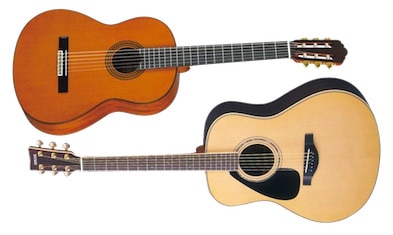
All About Acoustic Guitar String Gauges
Before we dive into the specific characteristics of various types of acoustic and classical guitar strings, let’s address the question of gauges since it applies to both types. Acoustic strings are manufactured in a range of thicknesses or gauges. These gauges are designated in thousandths of an inch. The lightest strings are typically .010 and the heaviest a .059. String gauge has a big influence on playability and sound. Most acoustic guitars ship with light or medium gauge strings, which are also known as 12s or 13s.
Note that classical guitar strings are also designated according to their tension. We will discuss the effect of tension on classical guitar playability and performance below.
Lighter gauge strings:
- are generally easier to play
- allow easier bending of notes and fretting
- break more easily
- produce less volume and sustain
- are prone to cause fret buzzing, especially on guitars with low action
- exert less tension on the guitar neck and are a safe choice for vintage guitars
Heavier gauge strings:
- are generally harder to play
- require more finger pressure to fret and bend notes
- produce more volume and sustain
- exert more tension on the guitar neck
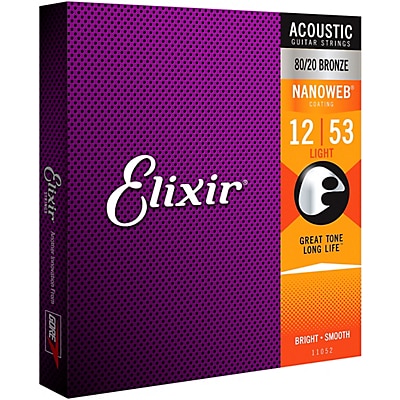
A set of Light Elixir Nanoweb Acoustic Guitar Strings have gauges that range between .012-.053 and a special polymer coating that greatly extends their life while producing bright, punchy tone.
Acoustic Guitar String Set Gauge Designations
Most acoustic guitar string manufacturers identify the string gauges in a set using terms such as “extra light” or “heavy.” While the exact gauges may vary slightly among manufacturers, here are typical gauge ranges for acoustic and electric guitar string sets:
Acoustic Guitar String Set Gauges
- “extra light": .010 .014 .023 .030 .039 .047
- "custom light": .011 .015 .023 .032 .042 .052
- "light": .012 .016 .025 .032 .042 .054
- "medium": .013 .017 .026 .035 .045 .056
- "heavy": .014 .018 .027 .039 .049 .059
Acoustic Guitar Steel Strings
Acoustic Guitar Steel String Gauges
In deciding what string gauges to use, consider the following factors:
Body Style: A general rule of thumb is to string smaller-bodied acoustics with lighter gauges, larger bodied instruments with heavier gauges. A big dreadnought or jumbo will generally sound better with medium-gauge strings that take fuller advantage of their relatively larger sound chambers. Smaller grand auditorium and parlor guitars will sound better with lighter gauges.
Playing Style: Fingerpicking styles are much easier to play with lighter-gauge strings. If most of your playing involves hard strumming, medium-gauge strings will likely be a better choice, though they may prove a little more challenging to new players’ fingers. If your playing is a mix of strumming and fingerpicking, a light-medium string set may be a good choice. These sets have heavier gauges on the bottom three strings, lighter gauges on the top three.
Desired Tone: As you’ve probably figured out by now, heavier-gauge strings will accentuate your guitar’s bass register producing the deep and strong tones that dreadnoughts are prized for. On the other hand, lighter gauges will provide more emphasis to treble notes and can help bring out subtle picking and strumming techniques.
Instrument Age and Condition: Vintage guitars are often frail, and the greater tension of heavier strings can cause necks to bow and shift and bridges to lift. If you’re not sure how heavy a gauge is safe for your guitar, consult the manufacturer, or in the case of vintage instruments, talk to a trusted guitar tech or luthier.
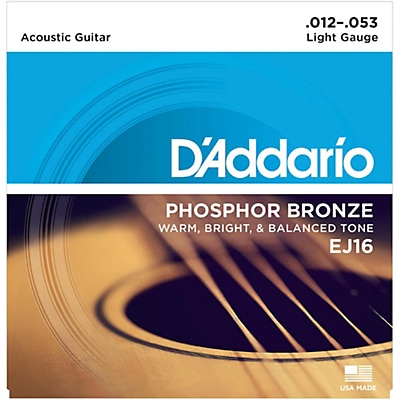
Perennial bestsellers at Musician’s Friend, D'Addario Phosphor Bronze strings get great reviews for both their tone and playability.
Acoustic Guitar String Construction Materials
Here are the sound characteristics of the most popular string types:
- Bronze: They have clear, ringing and bright tone, but age quickly due to bronze’s tendency to oxidize.
- Phosphor Bronze: Warmer and darker than bronze, their sound is still quite crisp and the phosphor in the alloy extends their life.
- Aluminum Bronze: Pronounced bass and crisp hi with greater clarity than phosphor bronze.
- Brass: They have a bright, jangling, metallic character.
- Polymer-coated: Less sustain and brightness than equivalent uncoated acoustic strings with good presence and warmth; corrosion-resistant. Some include colorants for visual appeal.
- Silk and Steel: These steel core strings have silk, nylon, or copper wrap wire on the lower strings producing a softer touch and delicate tone. Popular with folk guitarists and fingerstyle players.
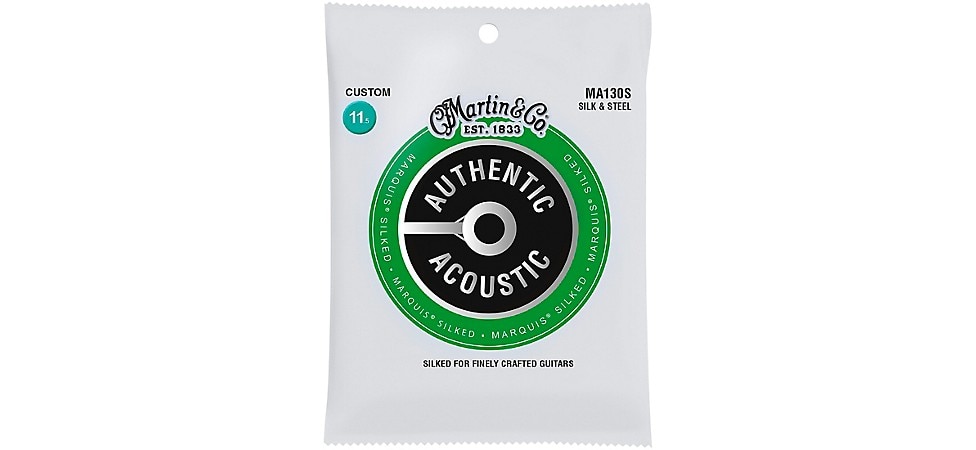
Martin Marquis Silk and Steel Strings have a soft silk wrap to prevent wear and tear on your instrument as you play.
String makers such as Martin produce phosphor bronze acoustic strings with different alloy compositions often designated with names such as 80/20 Bronze and 92/8 Bronze.
Other acoustic string variations include polymer-coated strings which offer longer life (typically with a brightness/sustain trade-off) and those with silk wraps on the ball ends of the strings that reduce wear and tear on the guitars bridge, end plate, saddle and pins.
The team at Martin Guitar demonstrates how to restring an acoustic guitar.
Do Acoustic-Electric Guitars Need Different Strings?
Most acoustic-electric guitars including a few nylon-string models are equipped with under-saddle piezo pickups. String vibrations are converted to an electrical signal with a small on-board preamp. Since piezo-based systems are non-magnetic, string materials may have less impact on your sound and ordinary acoustic guitar or classical guitar strings will work well. A few manufacturers produce strings expressly designed for acoustic-electric guitars, and you may want to compare their performance to standard acoustic strings.
In the case of acoustic-electric guitars equipped with both piezo and microphone or magnetic pickups, as well as acoustics with soundhole-mounted magnetic pickups, follow the string recommendations of the guitar and/or pickup manufacturer.
Classical Guitar Nylon Strings
Nylon String Characteristics
Nylon string guitars are generally used to play classical, flamenco, bossa nova, and folk music. That said, their softer, mellower tone and excellent touch response has been used to good effect by all kinds of guitarists including jazz and country players—Willie Nelson being a prime example.
Some new players choose nylon string guitars in the belief they will be easier on their fingers. Due to their softer material and lower tension, that is generally true. However, all new players experience some tenderness in their fingertips regardless of the guitar they choose. Provided the guitar’s action is properly adjusted for optimal playability, the new player should soon develop enough calluses so that tenderness is no longer an issue. A nylon string guitar should be selected on the basis of your musical interests, not because of initial ease of play.
Because nylon strings tend to stretch more than steel strings, they require more frequent tuning, especially when newly installed. They are also more sensitive to atmospheric changes caused by humidity and temperature.
Classical Guitar String Tension Designations
While classical guitar strings are sold in sets with specified gauges, they are also marketed according to each set’s tension ratings. Unfortunately, there is no clear-cut standard for these ratings, so a certain amount of experimentation among different string brands may be necessary to find what works for you. Complicating matters further, some packaged string sets mix and match tensions among the strings while only listing a single tension designation on the package. Here are the more common designations and their characteristics:
Low Tension (also sometimes called Moderate or Light Tension)
- Easier fretting, especially on guitars with a higher action
- Less volume and projection
- Less pronounced attack with more note “body”
- Best for smooth legato techniques
- Greater tendency to cause buzzing on frets
Normal Tension (also sometimes called Medium Tension)
- Usually strikes a balance between the characteristics of Low and High Tension strings
High Tension (also sometimes called Hard or Strong Tension)
- More difficult fretting, especially on guitars with high action
- More volume and projection
- More pronounced attack with less note “body”
- Best for strong rhythmic playing
- May cause issues with necks, bridges, and top bracing on fragile instruments
Some string makers also offer extra-light and extra-hard tension strings as well as middling sets with designations such as medium-hard. One recommended way to find the tension that’s right for your playing style and guitar is to first zero in on your preferred brand and wound string material. After those factors are established, try a set of each tension available in that string set to determine which works best with your ears and fingers.
It’s considered a good practice when using strings with higher tensions to detune the guitar after playing to reduce the possibility of damage caused by sustained tension.
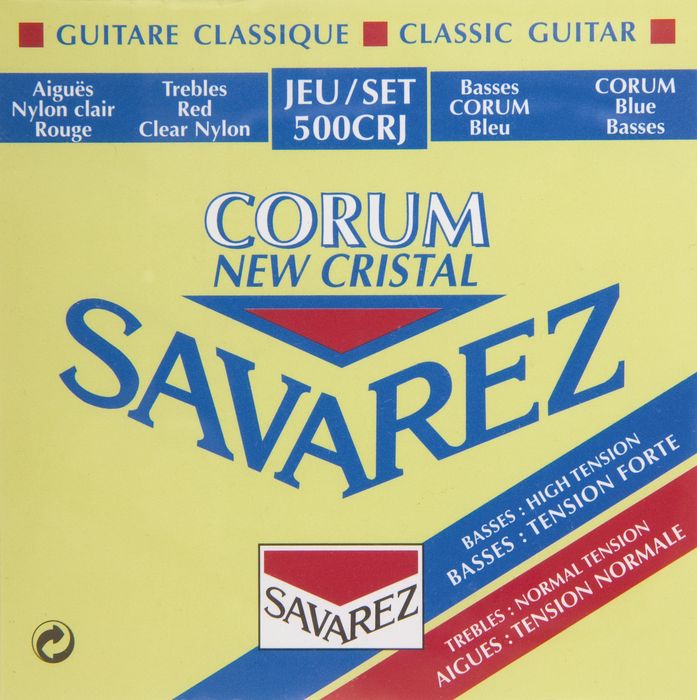
This Savarez Corum New Cristal classical guitar string set has high-tension basses and standard-tension trebles for an optimized tonal balance.
Tension is a cause for much debate among classical guitarists. As with string gauges and wound string materials and techniques, there is no pat answer. Experimentation is the key to finding what works best.
Nylon String Materials
It should first be pointed out that calling them “nylon” strings is a bit misleading. As noted below, there are several different materials that go into what more properly could be called classical guitar strings. You’ll also notice that the bass strings are constructed differently from the trebles.
Until the 1940s, classical guitar strings were made using the intestines of cows or sheep. The treble strings were made from plain gut while the three bass strings had a silk thread core wound with a gut wrap.
Modern classical, folk, and flamenco guitars use plain nylon, fluorocarbon, or other synthetic filaments on the treble strings (G,B, high E) and multi-filament nylon cores wrapped with various metals or nylon windings on the bass strings (E, A, D).
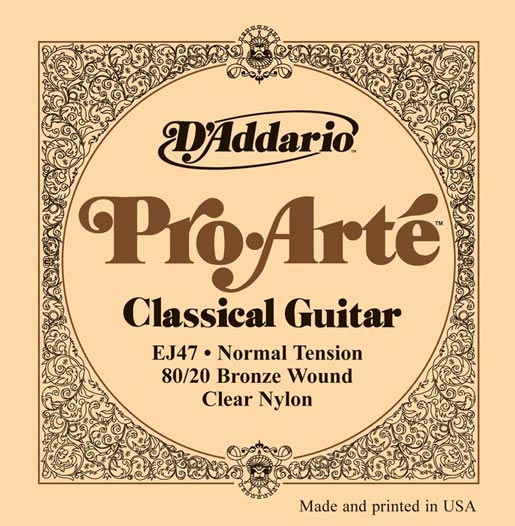
These Pro-Arte Classical Guitar Strings from D’Addario with 80/20 bronze wound on basses and clear nylon trebles get high marks for their consistency.
Classical Treble String Materials and Tonal Characteristics
Clear Nylon: Most popular, they’re made of clear nylon monofilament in note-specific gauges and known for their richness and clarity.
Rectified Nylon: Also made of clear nylon, they are then precision-ground to create a very consistent diameter along the string’s entire length. They have a mellower, rounder tone than clear nylon.
Black Nylon: Made from a different nylon composition, they produce a warmer, purer sound with more treble overtones. Popular with folk guitarists.
Titanium: Brighter than traditional nylon with a smooth feel. Often used on guitars with darker voices.
Composite: Made with a multi-filament composite, they have pronounced brightness and strong projection. They’re popular for use as G strings offering a smooth transition in volume between bass and treble strings.

Ernie Ball's 2406 Ernesto Palla classical guitar strings are made of black nylon monofilament, producing a warm, pure sound.
Classical Bass String Materials and Tonal Characteristics
Classical guitar bass strings have multi-filament nylon cores and are wrapped with a variety of metal winding materials. The most common winding materials are:
80/20 Bronze: Made of 80% copper and 20% zinc, it is sometimes referred to as brass. This alloy has pronounced brilliance and projection. Some manufacturers call them “gold” strings.
Silver-Plated Copper: The silver plating offers a very smooth feel while the copper produces warm tone. Some manufacturers refer to them as “silver” strings.
Roundwound strings are by far the most popular and common winding method found on classical guitar bass strings. Some manufacturers polish roundwound strings to flatten the top of the winding, resulting in a smoother feel and less finger noise.
Most classical guitar strings have straight ends and are designed to be tied on to classical guitar bridges. A few nylon strings have ball ends that are preferred by some folk guitarists. Unless ball ends are specified, you can assume classical strings have tie-ends.

For those who prefer easy-to-change ball-end strings, these Ernesto Palla Strings from Ernie Ball fill the bill nicely.
Martin Guitar demonstrates how to restring a classical guitar.
When Should I Change My Acoustic Guitar Strings?
- Getting your guitar in tune and staying in tune is more challenging than usual.
- Your strings are showing rust or discoloration.
- String wraps are unwinding exposing the core.
- Your tone sounds “flat” or “dead.”
- You can’t remember the last time you changed strings.
How Often Should Acoustic Guitar Strings be Changed?
If you're wondering "How often should I change my guitar strings?", there's no stock answer. Here are some factors that shorten the life of your strings:
- You sweat a lot when playing; your perspiration is acidic.
- You play aggressively with a lot of bending and/or hard picking.
- You play frequently.
- You change tunings frequently.
- You smoke or play your guitar in smoky environments.
Acoustic Guitar String Maintenance Tips
- Keep a clean cloth handy and wipe down your strings after every playing session to prolong their life.
- Washing your hands before playing will help prevent string oxidation.
- Invest in a string winder; they’re inexpensive and speed up string changes.
- Note the date you changed strings on the package, then put it in your case to keep track of the age and type of strings you’re using.
- Buying single strings in bulk can be a smart, budget friendly move, especially where light gauge strings you tend to break more frequently are concerned.
- Keep an extra set and a few high-register single strings in your case for emergency changes you or a bandmate may need.
After reading this guide, if you’re still unsure which acoustic strings are right for you, we invite you to call our friendly, knowledgeable Gear Heads.
Learn more with Musician’s Friend’s expert Acoustic Guitar Buying Guide.





































































































































